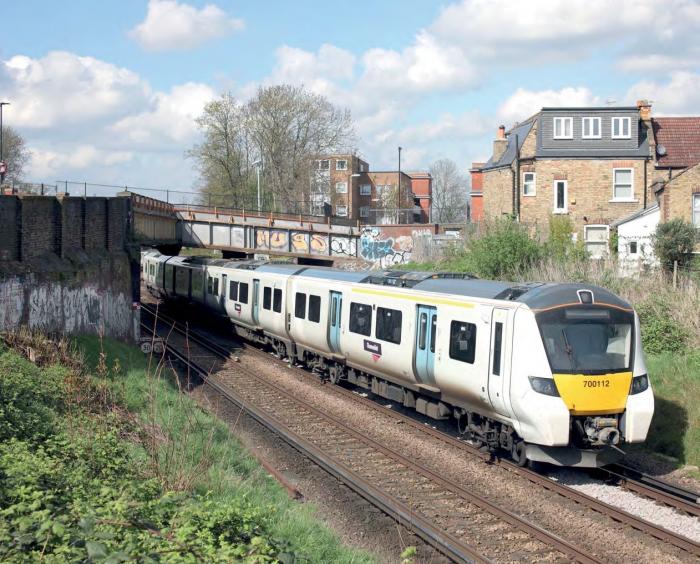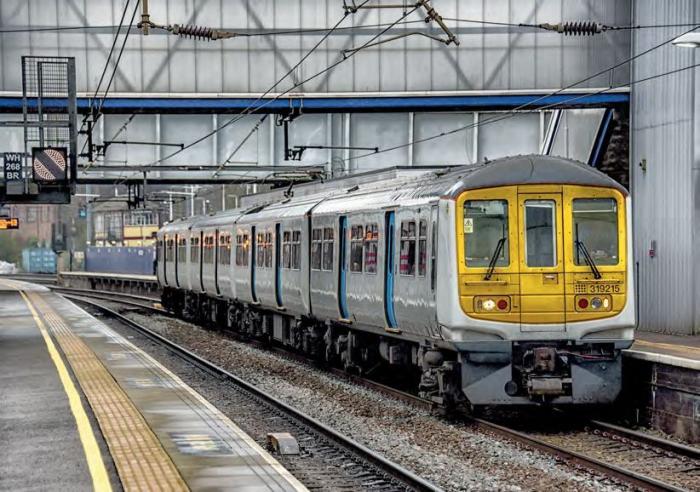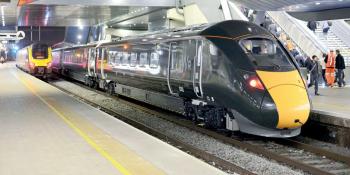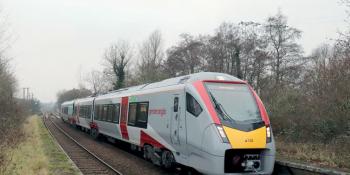Forget Birmingham – Thameslink will be the new heart of the UK network
Informed Sources

As reported in ‘News Front’ last month (p10), Network Rail Director Chris Gibb is leading an Industry Readiness Board (IRB) belatedly trying to resolve the problem that Thameslink forgot. A recent Thameslink user group meeting was told that when the full 24 trains per hour (24tph) service starts running in December next year, Thameslink will be at the heart of the UK network and that one train late at the central core will cause delays across the south of England.
However, the main problem facing the Red Adair of today’s railway troublespots is not the South East but the effect of Thameslink on the Midlands Engine and the Northern Powerhouse. The ‘first cut’ Thameslink timetable, released in December last year, was self-contained, requiring the long-distance operators to work out the implications for their services. And for the Midland main line (MML), in particular, the implications are considerable.
PHASED
Thameslink is due to open in two phases, with an initial service of 20tph from May 2018 followed by the full 24tph in December. However, the May timetable will introduce the full 16tph service on the MML in one go. In the peak this provides 8tph for Bedford and 4tph each for Luton and St Albans.
When the IRB’s revised timetable has been out to consultation in ‘late spring/early summer’, GTR will make its formal application to Network Rail for the paths in August. According to informed sources, resolving the conflicts between Thameslink and the MML and East Coast main line operators is not ‘impossible’. However, whether an acceptable compromise can be achieved in the limited time available is another matter. And that includes politically acceptable.
Which, in passing, raises the question, how can a multi-billion project, which was once known as Thameslink 2000, be a year away from service entry with a timetable that doesn’t work in network terms?
CRITICAL JUNCTIONS
While the MML appears to be a simple network, it includes key junctions for cross-country passenger and freight services that make the timetable vulnerable to knock-on effects. Thus, East Midlands Trains’ 125mph IC125s and Class 222 Meridians having to share the fast lines with more 100mph Thameslink EMUs means they will lose six to seven minutes between St Pancras and Bedford.
But this delay is compounded by the fact trains then go on to miss paths at the busy Leicester junction. This would add nine minutes in total to the London-Nottingham journey time.
For the Sheffield service, the delay at Leicester results in further missed paths at Derby. Hence the 12 minutes on London-Sheffield journey times quoted last month.
Nor is it just journey times.
Following the introduction of additional Thameslink fast line services in 2016, the busier railway has already had a significant effect on EMT’s right-time performance. GTR is clear that the new 24tph timetable will require a step change in regulation, much more resilience in terms of timetabling and train crew rostering and a high level of train reliability (see previous item). And that is just to make Thameslink run.
NORTHERN IRE
Informed sources doubt whether the extensive modelling for services north of Bedford needed to produce a working compromise can be completed in time for the August submission. Thameslink is also a highly political project, with the need for DfT to justify all the pain during the London Bridge works.

But equally political are the Government’s regional strategies. The MML serves the Midlands Engine and the Northern Powerhouse. Extended journey times for Sheffield at the expense of the cossetted southerners would not go down well.
OPTIONS
As with Crossrail, Thameslink is asymmetric. This raises the question of whether you need 16 paths per hour on the MML. One solution would be to turn back some services at Kentish Town, where there is stabling capacity and a tube station. EMT could then take over, say, some of the fast outer-suburban commuter services.
While GTR managers claim Thameslink’s junction outside Blackfriars will be at the ‘heart’ of the UK rail network, timetable modelling on the MML has been limited to a through service to Bedford, with EMT responsible for integrating services to the north. For example, alleviating the Leicester and Derby bottlenecks could involve splitting some of EMT’s regional through services with a change of train.
FRANCHISE FUTURE
But these timetable issues are of secondary importance when you consider the immediate future of the East Midlands franchise. Three bidders have been shortlisted for the replacement franchise and the current Direct Award franchise agreement has been extended to November 2018.
Meanwhile, the franchise is due to have six paths an hour in the December 2019 timetable when electrification between Bedford and Kettering/Corby is due to be commissioned. Installation of a fourth track throughout between Bedford and Kettering over the next 18 months is part of the strategy (East Midlands supplement p11, last month). The extra path will be allocated to the new EMU service.
In line with its current policy, DfT has been expecting the replacement franchisee to specify new rolling stock for EMT. But while that was feasible when the first Wilkinson-era rail franchise schedule was issued in March 2013, it has become increasingly untenable with the passing years.
According to the December 2016 version of the schedule, the Invitation to Tender was due to be issued this month (May) with the new franchisee taking over in July 2018. That the current direct award now runs to November 2018 is a reminder of how East Midlands is running away; that’s just over a year before the new electric service is due to be introduced.
With this timing, even Captain Deltic would be hard pushed to come up with a credible rolling stock strategy for the franchise, with new trains arriving in 2021 at the earliest. But before that, consider the infrastructure constraints.
OHLE CONSTRAINTS
While there is 25kV overhead line electrification (OHLE) between St Pancras and Bedford, this is limited to 100mph running. While NR has plans to upgrade this to 125mph by November 2023 (East Midlands supplement p11, last month), this schedule can only be regarded as provisional due to the funding constraints that can be expected in the next control period. Between Bedford and Kettering the new OHLE will be 125mph-capable.
North of Kettering, the Hendy date for completion of the MML electrification was 2023. Currently there is no date and Network Rail is winding back electrification as fast as it can (see next item).
How does this affect rolling stock? The assumption has been that the Kettering service would be served by cascaded EMUs (I know of some Class 707s going cheap – Ed). If cheap money and cheap EMUs are still available a new fleet might be affordable, but these would ideally be 125mph-capable, which might not be so cheap.

JAM PROMISED
‘At the same time, Network Rail is working on improvements which by 2019 will enable the next East Midlands franchise to deliver more carriages and faster journeys over the whole route, including almost twice as many seats into London St Pancras in the peak hours’. Paul Maynard, Rail Minister, 1 March 2017
But it is long-distance that causes the real problem. After Thameslink opens, EMT will need trains with strong acceleration to mix it with the Class 700s. With 750hp under each vehicle, the Class 222 Meridians are ideal.
However, with around 70% of the Meridian’s horsepower per tonne, the IC125 is not a fast starter. In any case, the IC125s will need to be replaced or expensively upgraded before the 1 January 2020 drop dead date for all trains to comply with the Passengers with Reduced Mobility Technical Specification for Interoperability (PRM-TSI).
With no prospect of electrification north of Kettering, EMT is going to need 125mph diesel traction just to maintain journey times to Derby, Nottingham and Sheffield, let alone exploit the proposed linespeed improvements touted as recently as March by DfT.
BI-MODE
About now, someone will be shouting ‘bi-modes’ at the written page. And if it is you, then you haven’t been paying attention.
A bi-mode doesn’t really work on the high-speed main line.
Under the wires it is a very heavy EMU, while under diesel power it is an underpowered DEMU. Just consider the roles on the MML. From London to Bedford it would need to run as a 125mph diesel. From Bedford to Kettering the pantograph could go up for some 125mph running. And after that it would be back to diesel. So why bother with the electric traction?
While it is clearly bonkers, what is needed is the modern equivalent of a Meridian in terms of performance. That’s 396 tonnes with 6,000hp, or 15hp/tonne.
To convert that to hard metal, you could probably match that power to weight ratio with two MTU-powered Class 43 equivalent driving power cars and six CAF Mk 5 coaches. Two plus eight would be slightly less spritely but still handy.
Oh, and by the way, this diesel Supertrain has to be available by 2020. Which is why the modern railway, whether high-speed inter-city or high capacity commuter, has to be an electric railway, which brings me to the next issue.




